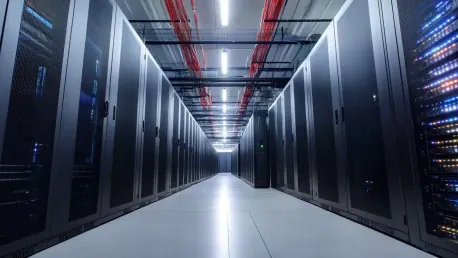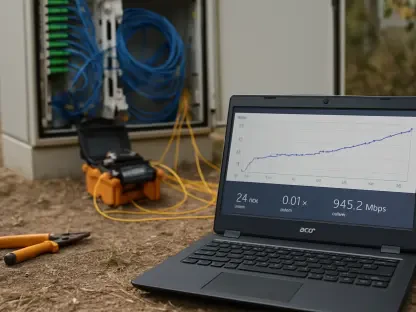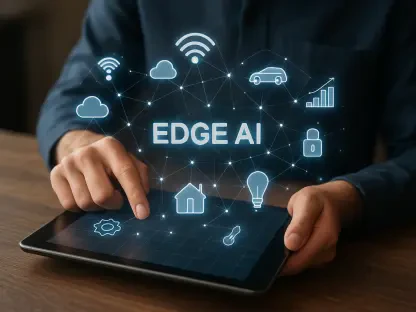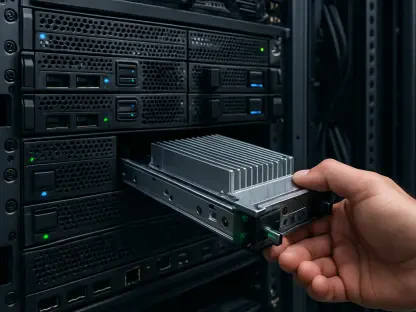Edge computing represents a fundamental shift by enabling data processing closer to the source, rather than relying solely on centralized cloud servers. This change enhances various aspects of data management, reducing latency, optimizing bandwidth, and boosting security and efficiency. This article explores the implications of edge computing on data centers, devices, and various industries.
Transforming Data Processing
Optimizing Interaction Between Data Centers and Devices
Edge computing allows data computation to occur closer to the origin, streamlining operations by ensuring only critical information reaches the cloud. In locations and circumstances where real-time responses are critical — such as autonomous vehicles and smart factories — this approach proves invaluable. For example, autonomous vehicles require immediate analysis of sensor data to navigate safely, while smart factories use real-time data to optimize production processes on-the-fly. By reducing data transit to central servers, latency is significantly minimized, allowing instantaneous decision-making and ultra-responsive operations.
This local processing paradigm also reduces the burden on cloud computing resources. Instead of transmitting entire data sets to the cloud, only essential data is sent, thereby conserving bandwidth and reducing network congestion. This method ensures that cloud resources are preserved for tasks requiring substantial computational power or extensive storage. Furthermore, it allows IoT devices and end-user applications to operate more smoothly and efficiently as they leverage nearby processing capabilities for quicker feedback and action. By fostering a symbiotic relationship between local and cloud resources, edge computing optimizes the entire data processing workflow and enhances overall system efficacy.
Advantages of Local Data Processing
The principal benefit of edge computing is processing data locally, which directly enhances bandwidth utilization and minimizes network congestion. End devices and local data centers share the responsibility of data management, ensuring that only crucial information is sent to the cloud. This results in more efficient handling of massive datasets and allows systems to function smoothly even under heavy loads. For instance, manufacturing plants can perform on-site data analysis to monitor equipment health and predict maintenance needs, reducing downtime and improving operational efficiency. Similarly, in the energy sector, smart grids use edge computing to manage and balance loads locally, ensuring a stable power supply while reducing strain on centralized servers.
Another significant advantage of local data processing is the potential for cost savings. By reducing the volume of data transmitted to the cloud, businesses can lower their cloud storage and data transfer costs. Additionally, local data centers can be optimized for specific tasks, leading to more efficient use of resources and lower energy consumption. This localized approach also opens up possibilities for more customized and context-aware applications, as data can be processed in close proximity to where it is generated, leading to more relevant and timely insights. This adaptability is particularly beneficial in industries such as healthcare, where real-time patient data analysis can improve diagnosis and treatment outcomes.
Enhancing Security and Privacy
Mitigating Cyber Threats
Processing data at the edge not only boosts efficiency but also enhances security measures. Businesses can mitigate cyber threats by keeping sensitive data within local data centers, thereby reducing risks associated with widespread transmission. This approach ensures that data remains protected within a secure environment, complying with data protection regulations. For instance, financial institutions can benefit from edge computing by conducting transactions and processing data locally, minimizing the risk of sensitive information being intercepted during transit. Additionally, industries such as healthcare and government agencies, which handle highly confidential data, can leverage edge computing to maintain higher levels of security and ensure compliance with stringent data protection laws.
Furthermore, localized data processing reduces the attack surface for potential cyber threats. By limiting the transmission of data across networks, the opportunities for cyber attackers to intercept or manipulate data are significantly decreased. This localized approach also allows for more rapid detection and response to security incidents, as edge devices can quickly identify and address threats in real-time. Implementing robust security protocols within these local environments ensures that data is safeguarded at every stage, providing a comprehensive defense against cyber threats. By integrating edge computing with existing security measures, businesses can create a more resilient and secure data management framework.
Enhancing Privacy
Localized data handling limits exposure to potential breaches during transit, thereby bolstering privacy and adding an additional layer of security for sensitive information. By processing data closer to the source, organizations can ensure that personal and confidential information remains within a secure perimeter, reducing the risk of unauthorized access. This is particularly relevant in sectors such as healthcare, where patient data privacy is paramount. By analyzing and processing patient data locally, healthcare providers can protect sensitive information from potential breaches while still leveraging advanced analytics to improve patient care.
In addition to enhancing privacy, edge computing allows for better compliance with data protection regulations, such as GDPR and HIPAA. These regulations often require that personal data be processed within specific regions and that organizations take appropriate measures to safeguard data privacy. By keeping data processing local, businesses can more easily adhere to these requirements and avoid potential penalties for non-compliance. Furthermore, edge computing enables organizations to implement granular access controls, ensuring that only authorized personnel can access sensitive data. This localized approach to data management not only strengthens privacy protections but also instills greater confidence in customers and stakeholders.
Harmonizing Edge and Cloud Computing
Edge computing refers to processing data closer to the source, thereby reducing latency and improving efficiency. On the other hand, cloud computing entails the centralized processing and storage of data in remote servers. Harmonizing these two computing paradigms can lead to enhanced performance, scalability, and resilience in data management and applications. The integration of edge and cloud computing aims to leverage the strengths of both approaches, providing a more balanced solution to meet the growing demands of modern technology ecosystems. By combining edge computing’s low latency with the cloud’s vast resources, businesses can optimize their operations and deliver better experiences to end-users.
Complementary Roles
Edge computing complements cloud computing rather than replacing it. The cloud remains vital for extensive analytics and storage, whereas localized data processing allows real-time monitoring and immediate data interaction. The symbiotic relationship between edge and cloud computing ensures that each technology is utilized for its strengths, creating a more efficient and effective data management system. For example, in smart cities, edge devices can monitor traffic flow and manage signals in real-time to reduce congestion, while cloud computing can analyze the collected data to identify long-term trends and inform urban planning decisions. This division of labor allows for both immediate responsiveness and comprehensive analysis, enhancing overall system performance.
Additionally, edge computing enables organizations to decentralize their data workflows, distributing tasks across multiple edge devices and local data centers. This not only reduces the load on central cloud servers but also increases system resilience and redundancy. In the event of a network failure or cyber attack, edge devices can continue to operate independently, ensuring continuity of service. Furthermore, this hybrid approach allows for greater scalability, as businesses can easily add new edge devices and data centers to accommodate growing data volumes and processing needs. By leveraging both edge and cloud computing, organizations can create a robust and flexible infrastructure that adapts to changing demands and challenges.
Example Applications
Smart factories utilize real-time data for operational agility with edge computing, while cloud computing aids in extensive analysis and predictive insights, exemplifying a harmonious division of roles between edge and cloud systems. In these environments, edge devices can monitor equipment performance, detect anomalies, and trigger maintenance actions in real time, ensuring smooth and uninterrupted production. Meanwhile, cloud-based systems can analyze historical data, identify patterns, and generate predictive models to optimize manufacturing processes and reduce downtime. This combination of immediate responsiveness and long-term analysis ensures that smart factories can operate at peak efficiency and adapt to changing conditions.
Another compelling example of edge and cloud computing working in tandem is in the agricultural sector. Modern farms equipped with IoT sensors and edge devices can monitor soil moisture, temperature, and crop health in real-time, enabling farmers to make informed decisions about irrigation, fertilization, and pest control. At the same time, cloud computing platforms can aggregate data from multiple farms, analyze it for trends, and provide insights into best practices and potential improvements. This integrated approach helps farmers maximize yields, reduce resource usage, and maintain sustainable practices. By leveraging the strengths of both edge and cloud computing, agricultural operations can achieve greater efficiency and productivity.
Real-World Applications in IoT
Traffic Management in Smart Cities
Edge computing is indispensable in IoT, such as in traffic management systems in smart cities. It enables real-time vehicle movement analysis, enhancing urban mobility and reducing congestion. By processing data from sensors and cameras locally, edge devices can quickly identify traffic patterns, detect accidents, and adjust traffic signals accordingly. This real-time responsiveness ensures that traffic flows smoothly and efficiently, reducing travel times and minimizing the environmental impact of idling vehicles. Furthermore, edge computing allows for the integration of various data sources, such as public transportation schedules and weather conditions, to create a comprehensive traffic management system that adapts to changing circumstances.
In addition to improving traffic flow, edge computing can enhance public safety in smart cities. For instance, edge devices can monitor video feeds from surveillance cameras and detect suspicious activities or unauthorized access to restricted areas. By processing video data locally, these systems can quickly identify potential threats and alert authorities, enabling a rapid response. This localized approach to security ensures that cities can maintain a high level of vigilance without overburdening central servers or compromising data privacy. By leveraging edge computing, smart cities can create safer, more efficient urban environments that cater to the needs of their residents.
Healthcare and Retail
In healthcare, patient monitoring devices analyze vital signs on-site, improving response times by processing data locally. These devices can quickly detect anomalies and alert medical staff, enabling timely interventions that can save lives. For example, wearable health monitors can continuously track heart rate, blood pressure, and oxygen levels, providing real-time feedback to patients and healthcare providers. This immediate access to critical data ensures that any deviations from normal parameters are promptly addressed, reducing the risk of complications and improving overall patient outcomes. Moreover, edge computing allows for the integration of data from multiple devices, creating a comprehensive view of a patient’s health and enabling more accurate diagnoses and personalized treatment plans.
In retail, smart inventory management enabled by edge computing optimizes stock levels and improves shopping experiences. By processing data from point-of-sale systems, shelf sensors, and customer interactions locally, retailers can gain real-time insights into product demand and inventory status. This allows for more efficient restocking, reducing the likelihood of out-of-stock items and ensuring that popular products are always available to customers. Additionally, edge computing can enhance the in-store experience by enabling personalized marketing and seamless checkout processes. For instance, smart mirrors in fitting rooms can suggest complementary items based on a customer’s selections, while mobile payment systems can quickly process transactions and reduce wait times. By harnessing the power of edge computing, retailers can create a more engaging and efficient shopping environment.
Challenges in Implementation
Infrastructure Management
Implementing edge computing poses significant challenges, particularly in managing diverse infrastructures. Deployment and maintenance of multiple data centers and devices require substantial investment and expertise. Organizations must ensure that their infrastructure can support the increased data processing and storage demands of edge computing, which often involves upgrading existing systems and integrating new technologies. This can be a complex and costly endeavor, especially for businesses with limited resources or technical expertise. Additionally, maintaining the reliability and performance of edge devices and local data centers requires ongoing monitoring and maintenance, which can strain IT departments and increase operational costs.
Another challenge in infrastructure management is ensuring that edge devices are compatible with existing systems and can seamlessly communicate with one another. Interoperability is crucial for the success of edge computing, as it enables different devices and platforms to work together efficiently. Achieving this level of compatibility often requires the adoption of standardized protocols and architectures, which can be difficult to implement and enforce across diverse environments. Furthermore, the rapid pace of technological advancements means that organizations must continually update their infrastructure to keep pace with new developments, adding another layer of complexity to edge computing implementation.
Interoperability and Security Risks
Ensuring seamless communication among various computing entities is complex, and security risks increase with the number of connected devices, necessitating robust safeguarding measures. As the number of edge devices and local data centers grows, so does the potential for security vulnerabilities. Each additional device represents a possible entry point for cyber attackers, making it essential for organizations to implement comprehensive security protocols that protect the entire network. This includes measures such as encryption, secure communication channels, and regular security updates to ensure that all devices are protected against emerging threats.
Moreover, maintaining data integrity and preventing unauthorized access are critical concerns in edge computing environments. As data is processed and stored across multiple locations, organizations must ensure that it remains consistent and accurate. This often involves implementing stringent access controls and authentication mechanisms to prevent unauthorized users from tampering with or accessing sensitive information. Additionally, organizations must be prepared to respond to security incidents quickly and effectively, minimizing the impact of any breaches and ensuring the continued protection of their data. By addressing these challenges and implementing robust security measures, businesses can create a secure and reliable edge computing infrastructure.
Edge Computing Frameworks
Available Solutions
In its deliberate approach to addressing the complexities of cryptocurrencies, the SEC opted for another delay in its verdict on the spot Ethereum ETF. The extension grants the SEC an opportunity not only to conduct an in-depth examination of Ethereum’s suitability for ETF status but also to source public insight, which could heavily sway the conclusion. This speaks to the SEC’s attentiveness to the nuances of digital assets and their integration into regulatory frameworks, which it does not take lightly. The situation closely parallels the stalling faced by Grayscale, who is also waiting for the green light to transform its Ethereum Trust into a spot ETF, raising questions about the contrasting regulatory processes for Bitcoin and Ethereum.
Various tech companies provide frameworks integrating data centers and devices with edge computing solutions. AWS IoT Greengrass, Microsoft Azure IoT Edge, and Google Distributed Cloud Edge are notable examples offering local data processing while maintaining cloud connectivity. These platforms enable seamless integration between edge and cloud computing, allowing organizations to leverage the strengths of both technologies. AWS IoT Greengrass extends the functionality of AWS services to edge devices, enabling local data processing, messaging, and machine learning capabilities. This allows businesses to manage and analyze data in real-time while still benefiting from the scalability and reliability of the AWS cloud.
Microsoft Azure IoT Edge provides a similar solution, offering a comprehensive suite of tools for deploying, managing, and securing edge applications. With support for AI and advanced analytics, Azure IoT Edge enables organizations to create intelligent edge solutions that can process data locally and respond to changing conditions in real-time. Google Distributed Cloud Edge, on the other hand, focuses on delivering high-performance computing and low-latency processing for applications that require immediate data interaction. By providing a flexible and scalable platform, these frameworks empower businesses to implement edge computing solutions that meet their specific needs and requirements.
Performance and Application Needs
These frameworks support applications requiring high-performance computing and low-latency processing, highlighting the integral role of edge computing in today’s technological landscape. Industries such as manufacturing, healthcare, and telecommunications benefit from the ability to process data locally, enabling real-time decision-making and reducing the need for constant cloud communication. For example, in manufacturing, edge computing can optimize production processes by monitoring equipment performance and predicting maintenance needs, ensuring minimal downtime and maximized efficiency. In healthcare, edge devices can analyze patient data on-site, providing timely insights and improving response times for critical medical interventions.
Telecommunications companies also leverage edge computing to enhance their network operations and service delivery. By deploying edge servers closer to end-users, these companies can reduce latency and improve the performance of applications such as video streaming, online gaming, and virtual reality. This localized approach allows for a more responsive and reliable user experience, fostering greater customer satisfaction and loyalty. Additionally, edge computing enables telecommunication companies to implement advanced analytics and AI-driven solutions, optimizing network management and resource allocation. By supporting a wide range of applications and performance requirements, edge computing frameworks play a crucial role in driving innovation and enabling new business opportunities.
Emerging Trends and Business Opportunities
Future Advancements
The growth of AI, 5G, and decentralized architectures will propel edge computing further. Intelligent data centers and devices will carry out complex tasks with minimal human intervention, driven by advancements in these technologies. AI-powered edge computing, for instance, allows devices to analyze data and make decisions autonomously, enabling more efficient and responsive operations. This is particularly relevant in industries such as transportation, where autonomous vehicles can process sensor data locally to navigate safely and efficiently. As AI algorithms become more sophisticated, edge devices will be able to handle increasingly complex tasks, further enhancing their capabilities and applications.
5G networks, with their high data transfer speeds and low latency, will also play a significant role in the growth of edge computing. The increased bandwidth provided by 5G enables faster and more reliable communication between edge devices and central servers, allowing for real-time data processing and analysis. This improved connectivity is essential for applications such as remote surgery, where low-latency communication is crucial for ensuring precision and accuracy. Additionally, decentralized architectures, such as blockchain, can enhance the security and reliability of edge computing networks by providing a transparent and tamper-proof record of data transactions. These technological advancements will drive the continued evolution of edge computing, opening up new opportunities and applications across various industries.
Strategic Adaptations
Businesses must implement strategies ensuring security and optimized data flow between edge and cloud systems. Advancements like AI models for low-power edge devices and 5G networks will streamline real-time analytics, opening new avenues in various industries. One such strategy involves adopting flexible and scalable cloud-edge integration frameworks that enable seamless communication and data sharing between edge devices and central servers. This ensures that critical data is processed locally while less time-sensitive information is transferred to the cloud for further analysis and storage. By maintaining a balanced and efficient data flow, businesses can optimize their operations and leverage the full potential of both edge and cloud computing.
Furthermore, companies must prioritize security measures to protect their edge computing infrastructure from potential cyber threats. This includes implementing robust encryption protocols, secure communication channels, and regular security updates to ensure that all devices and data are safeguarded. Additionally, businesses should invest in AI-driven security solutions that can detect and respond to threats in real-time, providing an added layer of protection. By adopting these strategies and staying ahead of emerging trends, organizations can fully harness the power of edge computing and capitalize on new business opportunities in areas such as AI-powered analytics, industrial automation, and smart cities.
Conclusion
Edge computing is a revolutionary approach that brings data processing closer to the original source, rather than relying exclusively on centralized cloud servers. By doing so, it significantly enhances various facets of data management. One key benefit is the reduction in latency, which means data can be processed more quickly and efficiently. Additionally, edge computing optimizes bandwidth usage, which is especially important in settings where connectivity may be limited or costly. This approach also enhances cybersecurity, as data is processed locally rather than being transmitted over potentially insecure networks. The shift towards edge computing has notable implications for data centers, as they must adapt to support this distributed model. Various industries stand to gain from this technology, as it allows for quicker decision-making, better customer experiences, and more efficient operations. This article delves into how edge computing impacts data centers, devices, and numerous sectors, highlighting the importance of embracing this new paradigm.









